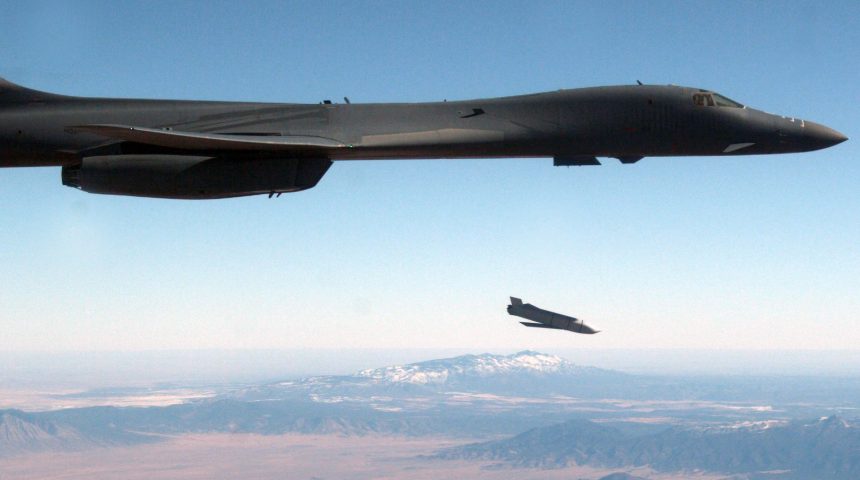A B-1 Lancer conducted an external weapon release demonstration launching a Joint Air-to-Surface Standoff Missile from an external pylon.
Last month, a B-1B Lancer assigned to the 412th Test Wing’s 419th Flight Test Squadron, Global Power Combined Test Force, flew a mission carrying an inert JASSM under an external pylon for the first time. The external captive carry flight, that took place in the skies over Edwards Air Force Base, California, saw the JASSM mounted on the forward right hard point, usually used to carry the SNIPER ATP (Advanced Targeting Pod).
As explained in our previous report, the next step of the testing that may pave the way to make the B-1B, aka “Da BONE”, to carry hypersonic weapons externally, was a weapons release from the external pylon, to validate that the JASSM and B-1 communicate correctly.
That external weapon release was successfully conducted at Holloman Air Force Base, New Mexico, on Dec. 4, 2020.
“A targeting pod pylon was modified mechanically to allow for different connector configurations, and the internal wiring was replaced with harnesses that would support its new role,” explained N. Keith Maynard, 812th Airborne Instrumentation Test Squadron, who serves as the Special Instrumentation (SI) Flight Chief, leading a group of more than 60 engineers, technicians, project managers and logisticians in a public release.
Here are some interesting details also included in the release:
“Although the modification required to reassign one of the internal weapon stations to the external location was well within our capability, it wasn’t part of our normal charter of data acquisition,” Maynard said. “Regardless, we jumped on the opportunity to help our customer and immediately assisted with the planning and provisioning and, when approved to do so, executed the modifications to the pylon and aircraft.”
The flight culminates the B-1B expanded carriage demonstration that began with a modified internal bomb bay demo in 2019. “Box drop” ground tests were conducted in October 2020 to verify the mechanical modifications to the pylon, before the captive carry flight took place
“In this case the Air Force Seek Eagle Office (AFSEO) performed modeling of the separation characteristics and determined that the JASSM separation from the B-1B pylon should replicate the normal JASSM control surface deployment timeline that occurs when launched from the Left Pylon station 2 of the B-52H,” said Agustin Martinez, 419th FLTS. “The prior captive carry flight verified that the JASSM received the correct information in order for it to follow the B-52H surface deployment timeline.”
The orifice settings and cartridges used for the MAU-12 Ejector Rack Assembly also ensured that the JASSM would separate with a nose-down pitch moment, which was confirmed during the box drop test earlier this year, Martinez added.
However, there is no substitute for physically releasing a JASSM while in-flight said Cory Coffman, Operations Engineer and Test Conductor, 419th FLTS.
“I’d say it’s pretty important,” he said. “Flight testing is a unique environment; ground tests and simulation are great, but there’s no alternative to flight test.”
To aid engineers in acquiring valuable weapon release data and characteristics, the B-1B Lancer was outfitted with the high-speed cameras able to capture up to 500 frames per second.
“The most important product for this specific mission is excellent imagery of the release from multiple angles to not only verify safe separation but to provide information about the weapon itself, like fin deployment,” Maynard said.
He explained that along with modification of the production weapons release systems, his team reconfigured the new digital high speed camera system installed on the aircraft, which was used to support the Long Range Anti-Ship Missile (LRASM).
The external hard points were initially thought for the B-1’s nuclear strike mission. However, the nuclear capability was scrapped and the type was converted to conventional only weapons with a shift decided in 1994 and a physical conversion that took place between 2007 and 2011, with the Strategic Arms Reduction Treaty (START). The current expanded carriage testing is aimed to make the external pylons available again for delivering conventional weapons so that the B-1 will remain complaint with the New START Treaty.
Dealing with the weapon involved in the tests, we have often talked about the AGM-158. The AGM-158s, both the baseline variant with a range in excess of 200 NM and the -ER version, with a standoff distance of over 500 NM, are GPS-guided radar-evading cruise missiles with 2,250-lbs penetrator/blast fragmentation warhead. The JASSM cruise missile employs precision routing and guidance in adverse weather, day or night, using an infrared seeker in addition to the anti-jam GPS to find and destroy high-value, well-defended targets.
The B-1 can currently carry 24 AGM-168 stealthy cruise missiles in its internal weapons bays.









